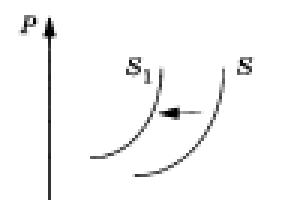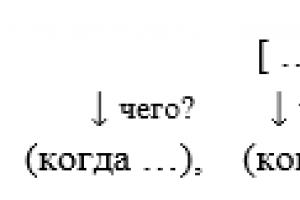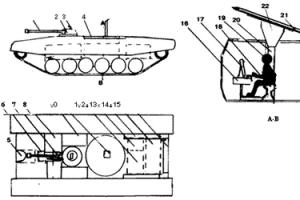Among sentences 3-10, find a complex sentence with heterogeneous (parallel) subordination of subordinate clauses. Write the number of this offer.
(3) Something has closed in Fyodor. (4) My head was empty. (5) In class, when they picked him up, he stood up, confused, not knowing what to say, and the guys already started giggling at him, immediately coming up with the nickname Gloomy Burcheev. (6) But Fyodor did not seem to hear this either. (7) His body seemed to have lost the ability to sense, and his soul to feel. (8) After classes, he got on the bus and went to the old district.
(9) On one of these visits, an excavator operator loading crushed stone into a dump truck shouted to Fedor:
- (10) Hey, guy! Clean up your dovecote!
Correct answer: 5
A comment:
A complex sentence with heterogeneous (parallel) subordination of subordinate clauses must, firstly, be complex, that is, have subordinating conjunctions; secondly, it is necessary that the subordinate clauses answer different questions, this is precisely the main feature of parallel subordination; thirdly, there must be at least three basics.
Proposition 5 meets all these conditions.
[In class, (when he raised), he got up, confused, not knowing], (what say), and the guys already started giggling at him, immediately coming up with the nickname Gloomy Burcheev.
Simple sentences within a complex sentence (SPP) are highlighted in brackets; stems are in italics.
What you need to know:
In a complex sentence there can be not one subordinate clause, but two, three, four or more. Subordinate clauses are connected not only with the main part of the sentence, but also with each other. This connection can be different in nature:
Homogeneous Subordination
Subordination is considered homogeneous, and subordinate clauses are considered homogeneous under two conditions:
- If subordinate clauses refer to the entire main clause or to the same word.
- They are clauses of the same type.
Example: She knew that the girls looked warily at the closed door of the room, that they felt connected... (Yu. German).
[ - = ], (what - =), (what = -)...
NoteThe subordinating conjunction (or allied word) in the second of the homogeneous subordinate clauses may be absent, but it can be easily restored from the first subordinate clause, for example: He was no longer afraid, although the thunder crackled as before and (although) lightning striped the whole sky (A. Chekhov). Pay attention to the absence of a comma between the two subordinate clauses: there is none, since the subordinate clauses are homogeneous and are connected by the conjunction I.
[ = ], (although - =) and ((although) - =).
Heterogeneous (parallel) subordination
If of the two conditions of homogeneous subordination only one is satisfied and the other is not, then we are dealing with heterogeneous (parallel) subordination.
Thus, subordinate clauses with heterogeneous subordination either refer to one thing, but at the same time are subordinate clauses of different types, or, being subordinate clauses of the same type (usually these are attributive clauses), refer to different words.
Example: When we got up, it was impossible to understand what time it was (A. Chekhov).
(When - =), [then = ], (which -).
Consistent submission
With sequential subordination, subordinate clauses are connected to each other as if in a chain: the first subordinate clause refers to the main clause (this is a subordinate clause of the 1st degree), the second subordinate clause refers to the first (subordinate clause of the 2nd degree), the third - to the second (subordinate clause of the 3rd degree), etc.
Example: It was a beautiful July day, one of those days that happen when the weather has settled for a long time (I. Turgenev).
[ = - ], (which =), (when - =).
With sequential subordination, a combination of two subordinating conjunctions or a subordinating conjunction and a conjunction word (what if, what when, what why, etc.) is possible. In such cases, the second clause appears inside the first.
It so happened that when we were driving, there was not the slightest swell (M. Prishvin).
[ = ], (what, (when - =), =)
Combined submission
In a complex sentence with a large number of subordinate clauses, combined subordination is possible (homogeneous and parallel, homogeneous and sequential, sequential and parallel; homogeneous, sequential and parallel).
Example:In the evening the storm became so intense that it was impossible to hear whether the wind was humming or thunder roaring.(I. Goncharov) (consistent and homogeneous submission)
[ - = ], (what =), (= whether -) or (= -).
(consistent and homogeneous subordination).
Example: To move forward, look back often, otherwise you will forget where you came from and where you need to go(L. Andreev).
(To =), [ = ], (otherwise - =), (from where - =) and (where =).
(homogeneous, parallel and sequential submission).
In this chapter:
§1. Types of subordination in NGN with several subordinate clauses
An IPP can have more than one subordinate clause. In this case, it is important to understand how all the parts of a complex sentence are related to each other, what obeys what. Three types are possible:
1) consistent submission,
2) parallel subordination,
3) homogeneous subordination.
Consistent submission
With sequential subordination, a chain of sentences is formed: the first subordinate clause is subordinate to the main clause, the second subordinate clause is subordinate to the first subordinate clause, etc. With this type of subordination, each subordinate clause is the main one for the subsequent subordinate clause.
I'm afraid that Anna will be late for the exam, which is scheduled to start early in the morning.
Scheme: [...], (union What...), (conjunctive word which…).
With sequential subordination, the subordinate clause related to the main one is called a subordinate clause of the first degree, and the next subordinate clause is called a subordinate clause of the second degree, etc.
Parallel subordination
If subordinate clauses of different types belong to one main sentence, then parallel subordination is formed. With this type of subordination, both subordinate clauses belong to the same main clause. It is important that these clauses are of different types and they answer different questions.
When the teacher came in, the kids stood up to greet her.
Scheme: (conjunctive word When…), [ … ], (union to …).
Homogeneous Subordination
If subordinate clauses are sentences of the same type and refer to the same member of the main sentence or the entire main sentence as a whole, then a homogeneous subordination is formed. With homogeneous subordination, subordinate clauses answer the same question.
I suddenly felt how the tension subsided and how light my soul became.
Scheme: [...], (union How...) and (union How …).
Subordinate explanatory clauses are similar to homogeneous members of the sentence; they are connected to each other by the conjunction And. Both subordinate clauses refer to the main clause of the sentence. There is no comma between them.
It is important that with homogeneous subordination, conjunctions or allied words can be omitted, which is typical for sentences with several subordinate clauses.
Test of strength
Find out your understanding of this chapter.
Final test
Is it true that an IPP can have more than one subordinate clause?
What is subordination called when the first subordinate clause is subordinated to the main clause, the second to the first, etc.?
- consistent submission
- homogeneous subordination
- parallel subordination
What is subordination called when subordinate clauses of different types are attached to one main clause?
- consistent submission
- homogeneous subordination
- parallel subordination
What is subordination called when subordinate clauses are sentences of the same type and refer to the same member of the main sentence or the entire main sentence as a whole?
- consistent submission
- homogeneous subordination
- parallel subordination
When the performance ended, the children clapped so that the artists felt their gratitude.?
- consistent submission
- parallel subordination
- homogeneous subordination
What is subordination in a sentence: I think that in the next episode the hero will save the girl he is in love with.?
- consistent submission
- parallel subordination
- homogeneous subordination
What is subordination in a sentence: I heard the door slam and people talking in the hallway.?
- consistent submission
- parallel subordination
- homogeneous subordination
What is subordination in a sentence: I think that my brother will be happy with my gift and that I made a very good choice.?
- consistent submission
- parallel subordination
- homogeneous subordination
If drawing up diagrams for complex sentences is still difficult for you, read this article carefully. It contains examples of complex sentences with patterns of all possible types. Read them carefully and the task of creating an outline for a complex sentence will no longer seem difficult to you.
What is a complex sentence
Difficult to subordinate is a sentence whose predicative parts are in unequal relationships with each other. One of the parts is the main one, the other (others) is the subordinate part, i.e. dependent on the main one. The subordination of a subordinate clause is expressed using subordinating conjunctions and allied words.
In addition, a subordinate clause can refer to the entire main clause as a whole (that is, extend it) or to some word in its composition.
Types of complex sentences by meaning
Depending on what kind of conjunctions and allied words the subordinate clause is attached to the main one and what semantic relationships develop between the parts of the dictionary, the latter are divided into several types. To make it shorter, we will call the types of complex sentences by types of subordinate clauses:
Subordinate clause explanatory. Connection with the main sentence is carried out through conjunctions what, how, to, whether.
Father said that mother would return from work late.
[ … ], (What …).
Subordinate clause definitive. Communication with the main sentence is carried out using allied words which, which, whose, what, where, where, from, how.
No one could remember whose yellow umbrella stood in the corner all evening.
[ ... ], (whose …).
Subordinate clause connecting. Communication with the main sentence is carried out using allied words why, why, why, all case forms of the word What.
Explain to me clearly why Nastya is doing all this.
[ … ], (For what …).
Subordinate clause circumstantial. This meaning expresses a large number of conjunctions and allied words. Therefore, this type of NGN is divided into several more subparagraphs, depending on what adverbial meanings are expressed by means of communication (conjunctions and allied words).
The children were looking forward to the holiday finally coming and the Christmas tree being brought into the house.
[...], (when...), and (...).
Circumstantial meanings:
places(means of connection between the subordinate and main parts - allied words where, where, where);
They walked for a long time, stumbling, and in the evening they came to the edge of the forest, from where the road to the city was visible.
[ ... ], (where …).
time when, while, only, only);
And she kept calling and crying, crying and calling, until the window finally opened.
[ … ], (Bye …).
conditions(means of connection between subordinate and main parts - conjunction If and so on.);
If you go straight now and turn right at the corner, you can go straight to the library.
(if...), [then...].
causes(means of connection between subordinate and main parts - conjunctions because, since);
Children often act against the will of their parents, because young people want to quickly try their own strength.
[ … ], (because…).
goals to);
To achieve your dream, you will have to try hard.
(to …), [ … ].
consequences(a means of connecting the subordinate and main parts - conjunction So);
The actor prepared a lot for the audition, so he was able to get the role.
[ ... ], (So…).
concessions(a means of connecting the subordinate and main parts - conjunction Although);
Although I had never been in a hot air balloon before, operating the burner and keeping the basket at the right height was not too difficult.
(Although …), [ … ].
comparisons(means of connection between subordinate and main parts - conjunctions as if, as if, than);
Everything was spinning and swimming before my eyes, as if a stupid colored carousel had spun me in a circle.
[...], (as if...).
measures and degrees(means of connection between subordinate and main parts - conjunctions what to and allied words how much, how much);
I cannot express in words how grateful all these people are for your timely help!
[...], (how much...).
course of action(means of connection between subordinate and main parts - conjunctions what, in order, as if, how, exactly, as if, as if and a union word How).
Gather your courage and dance as if there is not a single person in the entire large hall.
[...], (as if...).
Position of the subordinate clause in the IPP
As you may have noticed when looking at complex sentences with diagrams, the positions of the main and subordinate clauses are not rigidly fixed; you can come up with several different combinations.
A subordinate clause can be placed before the main clause:
No matter what difficulties await you along the way, you must persistently pursue your cherished goal!
(which …), [ … ].
The subordinate clause can be placed after the main clause:
Go to your mom and ask her to help us.
[ … ], (to …).
A subordinate clause can be included inside the main clause:
Everywhere we went, we were followed by surprised glances.
[ …, (Where …), … ].
Obviously, there does not have to be one subordinate clause in the NGN. There may be several of them. Then it is worth considering all the options for what kind of relationship develops between subordinate clauses and the main one.
It is also worth clarifying that the scheme of a complex sentence can be not only linear ( horizontal), as in the examples above. Flowcharts ( vertical).
So, for several subordinate clauses the following cases are possible:

Scheme for parsing a complex sentence
A reasonable question may arise as to why all these NGN schemes are needed. They have at least one practical purpose - an obligatory part of the syntactic parsing of a complex sentence is the compilation of its diagram.
In addition, the diagram of a complex sentence will help to correctly analyze it for parsing.
SPP parsing diagram includes the following task items:
- Determine whether the sentence is based on the purpose of the statement: narrative, interrogative or motivating.
- What - according to emotional coloring: exclamatory or non-exclamatory.
- To prove that a sentence is complex, you need to define and indicate the grammatical basics.
- Indicate what type of connection between parts of a complex sentence is present: conjunction, intonation.
- Indicate the type of complex sentence: complex sentence.
- Indicate how many simple sentences are included in a complex one, and by what means subordinate clauses are attached to the main one.
- Label the main and subordinate parts. In the case of a complex sentence with several subordinate clauses, they should be designated by numbers (degrees of subordination).
- Indicate which word in the main sentence (or the entire sentence) is associated with the subordinate clause.
- Note the way of connecting the predicative parts of a complex sentence: a conjunction or a conjunctive word.
- If there are any, indicate indicative words in the main part.
- Indicate the type of subordinate clause: explanatory, attributive, connecting, adverbial.
- And finally, draw up a diagram of a complex sentence.
To make it clearer, parsing sample complex sentence:
The sentence is narrative, non-exclamatory, complex. This is a complex sentence made up of four simple clauses. Means of communication: intonation, allied word When, subordinating conjunction What.
The SPP consists of one main and three subordinate clauses: the first (2) and second (3) subordinate clauses are attributive, both extend the word day in the main sentences and answer the question which? Connected together by a coordinating conjunction And. The third subordinate clause (4) is adverbial (measures and degrees), extends the predicate of the second subordinate clause (3) and answers the questions how much? to what extent?
Thus, this is a complex sentence with the following types of subordinate clauses: homogeneous and consistent.

Summary
We examined in detail different schemes of complex sentences with examples. If you have carefully read the article, no task related to SPP will no longer seem difficult to you.
We also focused on the types of IPS schemes (horizontal and vertical). And, most importantly, how these diagrams will help you correctly parse complex sentences.
website, when copying material in full or in part, a link to the source is required.








